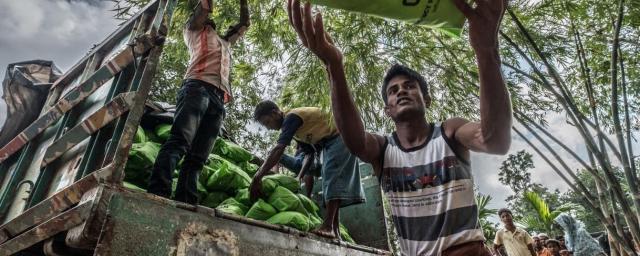
Oxfam's local partner Coast Trust helps to pack and load the food kits at Oxfam's warehouse in Cox Bazaar, Bangladesh. (Photo: Tommy Trenchard/Oxfam)
Every year since 2008, the world has become less peaceful. From climate-related disasters to long-lasting conflicts and insecurity, we witnessed a rise in the scale and frequency of humanitarian crises, increasing the number of vulnerable people, displaced, at risk or in need of assistance.
In Syria, Yemen, or South Sudan, conflicts continue to threaten and destroy the lives of millions of women, men and children, trapping them in a vicious cycle of violence, poverty and inequality. Hunger is again on the rise, reversing years of progress.
The number of climate-related disasters has tripled in 30 years, causing harm and suffering to communities across the globe. By the 2030s, large parts of Southern, Eastern and the Horn of Africa, and South and East Asia will experience greater exposure to droughts, floods, and tropical storms.
Let's look at the numbers
Overall, more than 132 million people across the world need humanitarian assistance and protection.
One-third of the world’s poor live in fragile and conflict-affected countries. By 2030, this share is likely to grow to one-half.
In 2019 the number of people who have been forced from their homes by war and persecution reached 68 million – the highest number since World War II.
The number of people going hungry worldwide is growing, reaching 690 million in 2019.
An Oxfam’s analysis shows that, on average, 14 million people were reported newly displaced by extreme weather disasters each year over the period 2008-2016.
Delivering high quality aid: Oxfam's response
Oxfam has a long and well-recognized record of humanitarian relief in times of crisis. When disaster strikes, we respond - delivering high quality lifesaving assistance and essential protection to the most affected. We make sure people can get clean water to drink and decent sanitation. We provide help for them to get food and the essentials they need to survive, and we work with people on the journey to self-sufficiency.
Through our long-term development programs, we stay well after the dust has settled to help rebuild communities to come back stronger from disaster and support them in being better prepared to cope with shocks and uncertainties.
Building resilience and local capacity
The scale and nature of these humanitarian crises have led us to put more emphasis on building the resilience of affected populations and increasing national and local response capacity and ownership. We recognize that local responders are often the best placed to help in emergencies, and we work with governments, local organizations, and communities so that they are ready to respond in emergencies, and able to cope when crisis hits.
Supporting women’s rights and gender justice
In all our responses, we prioritize the needs of women and girls, who are often discriminated against or have fewer resources to face and recover from emergencies. We promote the safe and accessible use of our humanitarian programs by women and girls, and support women's organizations to lead in emergency preparedness, risk reduction, and response.
Campaigning and influencing others
The goal of our campaigning is not just to speak for people in need, but to open the way for them to speak for themselves. A key part of our humanitarian work is campaigning and using our influence to make sure women, men, and children are provided the assistance they need and have their rights respected. We also seek to address and ultimately remedy the political and structural root causes of their vulnerability.